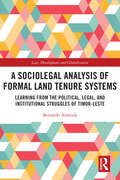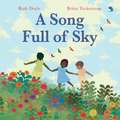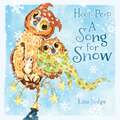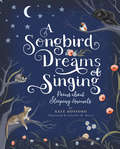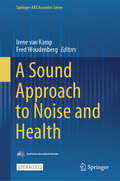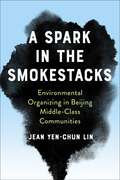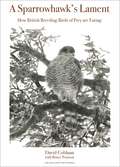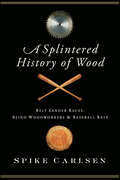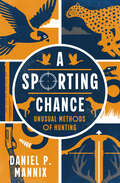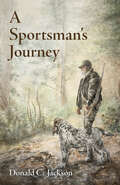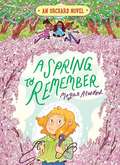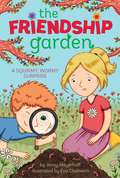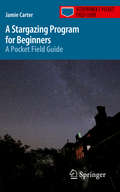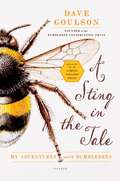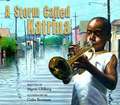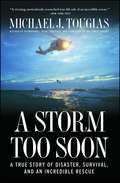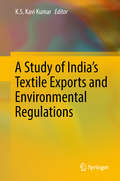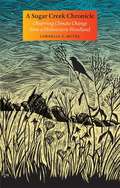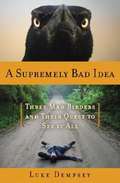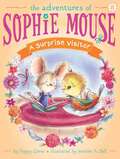- Table View
- List View
A Sociolegal Analysis of Formal Land Tenure Systems: Learning from the Political, Legal and Institutional Struggles of Timor-Leste (Law, Development and Globalization)
by Bernardo Ribeiro AlmeidaThis sociolegal study focuses on the political, legal and institutional problems and dilemmas of regulating land tenure. By studying the development of the Timorese formal land tenure system, this book engages in the larger debate about the role of state systems in addressing and aggravating social problems such as insecurity, poverty, inequality, destruction of nature, and cultural and social estrangement. Land tenure issues in Timor-Leste are complex and deeply shaped by the nation’s history. Taking an insider’s perspective based on the author’s experience in Timorese state administration, and through the investigation of five analytical themes –political environment, lawmaking, legal framework, institutional framework, and social relationships and practices– this book studies the development of the Timorese formal land tenure system from independence in 2002 to 2018. It shows how political, legal, and administrative decisions on land administration are made, what and who influences them, which problems and dilemmas emerge, and how the formal system works in practice. The result is a portrait of a young nation grappling with the enormous task of creating a land tenure system that can address the needs of its citizens in the wake of centuries of socio-political tumult and huge fluctuations in resources. The book concludes by highlighting the importance of lawmaking and how abuses of power can be curbed by adequate administrative processes and laws. Finally, it argues that land administration is primarily a political matter. The political dimension of technical solutions must be considered if we aim to achieve fairer formal land tenure systems. The pertinence of the topics covered, the multi-disciplinary perspective, and the research methodology followed make this book appealing to a variety of readers, including international organizations, practitioners, academics and students engaged in land administration, post-colonial and -conflict issues, lawmaking, rule of law, public administration and issues of access and exclusion.
A Song Full of Sky
by Ruth DoyleA joyful picture book celebrating the beauty and wonder of nature, and its power to improve well-being whilst soothing anxieties among little onesFrom galloping horses to moon-dappled owls, sun-scented flowers and soft floating bees, this joyful picture book celebrates the beauty and wonder of nature - and encourages every child to claim their rightful place within it!A powerful manifesto for reconnecting with nature, wherever we find it.
A Song for Snow (Hoot and Peep)
by Lita JudgeA young owl experiences the magic of a first snowfall—the quiet wintery wonder, the pristine beauty, and snowballs!—in this follow-up to the adorable Hoot and PeepIt&’s Peep&’s first winter, and it&’s going to snow very, very soon. Peep has so many questions for her older brother Hoot: Does snow drop, polppety splop, like the rain's song? Does it scrinkle scrattle like falling leaves? But Hoot can't remember snow very well. The one thing he knows for sure is that it is worth waiting for.But Peep doesn't have his patience, and as she flies around the gorgeous Paris skies, she tries her best to make up her own snow song. But once those first snowflakes start to fall, Peep realizes just how wise her older brother really is for waiting...and just who she wants to cuddle up to when the snow starts to really sing.With all the wonder and the joy of a first snow day, and perfect for fans of The Quiet Book and Little Owl's Night, this tender follow-up to Hoot and Peep is certainly worth waiting for, too.
A Song of Sun and Sky
by Jason CockcroftA seemingly endless road trip for Lula and her father only seems to get worse when the car breaks down in the middle of the desert. Things are too boring and too orange until Lula encounters a mysterious painter who shows her that the desert is full of so much more to explore. This is an exploration of color, lighting, and the magic of art and nature, filtered through the lens of a fictional interaction with the artist Georgia O'Keeffe. Learn about the colors you bring along everywhere you go.
A Songbird Dreams of Singing: Poems about Sleeping Animals
by Kate HosfordLearn more about the variety of fascinating ways animals sleep: from upside down and holding hands, to sleeping while swimming or flying!Did you know otters sleep while holding hands; zebra finches rehearse their songs while dreaming; ducks and dolphins sleep with one half of their brains at a time; and, frigate birds sleep while flying? A Songbird Dreams of Singing: Poems about Sleeping Animals is a book of poetry with a scientific-and child-friendly-underpinning. With a poem for every animal, followed by a paragraph explaining the fascinating science behind how that animal sleeps, this artfully compiled book captures the wonder of our ecosystem. Designed with the look of a classic storybook/collection, with special effects on the cover, the book makes the perfect gift for young children!
A Sound Approach to Noise and Health (Springer-AAS Acoustics Series)
by Irene Van Kamp Fred WoudenbergThis open access book highlights the negative and positive health effects of chronic exposure to environmental sound. It describes the state of the art in the field from a public health point of view and puts it in a broad societal perspective looking at sound from physical, social, psychological, economic and governance angles. Rather than a mere collection of papers around the theme as usually provided in special issues, this book offers a comprehensive look at the meaning of sound in society and its impacts and provides directions to further advance the field.
A Spark in the Smokestacks: Environmental Organizing in Beijing Middle-Class Communities
by Jean Yen-chun LinEnvironmental organizing in Beijing emerged in an unlikely place in the 2000s: new gated residential communities. After rapid population growth and housing construction led to a ballooning trash problem and overflowing landfills, many first-time homeowners found their new neighborhoods facing an unappetizing prospect—waste incinerator projects slated for their backyards.Delving into the online and offline conversations of communities affected by the proposed incinerators, A Spark in the Smokestacks demonstrates how a rising middle class acquires the capacity for organizing in an authoritarian context. Jean Yen-chun Lin examines how urban residents create civic life through everyday associational activities—learning to defend property rights, fostering participation, and mobilizing to address housing-related grievances. She shows that homeowners cultivated petitioning skills, informational networks, and community leadership, which they would later deploy against incinerator projects. To interact with government agencies, they developed citizen science–based tactics, a middle-class alternative to disruptive protests. Homeowners drew on their professional connections, expertise, and fundraising capabilities to produce reports that boosted their legitimacy in city-level dialogue. Although only one of the three incinerator projects Lin follows was ultimately canceled, some communities established durable organizations that went on to tackle other environmental problems.Drawing on interviews, participant observation, and ethnography, A Spark in the Smokestacks casts urban Chinese communities as “schools of democracy,” in which residents learn civic skills and build capacity for collective organizing. Through compelling case studies of local activism, this book sheds new light on the formation of civil society and social movements more broadly.
A Sparrowhawk's Lament: How British Breeding Birds of Prey Are Faring (WILDGuides #71)
by David CobhamBritain is home to fifteen species of breeding birds of prey, from the hedgerow-hopping Sparrowhawk to the breathtaking White-tailed Eagle. In this handsomely illustrated book, acclaimed British filmmaker and naturalist David Cobham offers unique and deeply personal insights into Britain's birds of prey and how they are faring today. He delves into the history of these magnificent birds and talks in depth with the scientists and conservationists who are striving to safeguard them. In doing so, he profiles the writers, poets and filmmakers who have done so much to change the public's perception of birds of prey. There are success stories—five birds of prey that were extinct have become reestablished with viable populations—but persecution is still rife. Featuring drawings by famed wildlife artist Bruce Pearson, this book reveals why we must cherish and celebrate our birds of prey, and why we neglect them at our peril.
A Splintered History of Wood: Belt-Sander Races, Blind Woodworkers & Baseball Bats
by Spike CarlsenIn a world without wood, we might not be here at all. Without wood, we wouldn't have had the fire, heat, and shelter that allowed us to expand into the colder regions of the planet. If civilization somehow did develop, our daily lives still would be vastly different: there would be no violins, baseball bats, chopsticks, or wine corks. The book you are now holding wouldn't exist. At the same time, many of us are removed from the world where wood is shaped and celebrated every day. That world is inhabited by a unique assortment of eccentric craftsmen and passionate enthusiasts who have created some of the world's most beloved musical instruments, feared weapons, dazzling architecture, sacred relics, and bizarre forms of transportation. In A Splintered History of Wood, Spike Carlsen has uncovered the most outlandish characters and examples, from world-champion chainsaw carvers to blind woodworkers, the Miraculous Staircase to the Lindbergh kidnapping case, and many more, in a passionate and personal exploration of nature's greatest gift.
A Sporting Chance: Unusual Methods of Hunting
by Daniel P. MannixThe award-winning author of The Way of the Gladiator shares his experiences hunting with strange devices—and animals—in this classic book. Falcons, boomerangs, spears. . . In the mid-twentieth century, hunters of all shapes and sizes were in favor of giving their quarry a fighting chance. A revival of ancient sporting techniques was taking the hunting world by storm. The old ways required more skill and were, therefore, a greater challenge. They also brought people closer to nature. Among those embracing this philosophy was author Daniel P. Mannix, who was more interested in learning an antique skill than shooting a new gun. In these pages, he delves into the history of hunting and gives readers firsthand accounts of his attempts at bagging pigeons with a feral cat (an ocelot named Tiba), using a blowgun with poisoned darts for deer in Mexico, teaching an otter to retrieve downed ducks, tracking—and trapping—humans, and other odd, old-school techniques.&“A gripping compendium of hunting devices and trained animals that give the prey a sporting chance, this is easily the best hunting book in years.&” —Kirkus Reviews
A Sportsman's Journey
by Donald C. JacksonA Sportsman's Journey lyrically and spiritually connects readers with the natural world. Donald C. Jackson explores the rhythms and ways of hunting and fishing, particularly in America’s Deep South, and in so doing helps readers understand and find meaning in why hunters and anglers venture far afield. Journeying alongside the author, readers will savor the magic of sunrises and the mystery of twilight. Hearts will quicken as deer drift from shadows and ducks circle a woodland pond. The ocean will challenge them as they fight large fish from the deck of a wave-tossed boat far out at sea. Restless winds will whisper messages during a spring squirrel hunt on a Mississippi farm. Bird dogs, old guns, old friends, and times shared with loved ones will remind anglers and hunters of those special, shared memories. Ancient forests and powerful rivers remind us of our fragile, ephemeral state. Quail hunts strengthen cherished relationships with companions. Encounters with a mountain man will take us into a world thought to have vanished generations ago. A gathering of anglers on a Gulf Coast fishing pier at night reminds us of those hidden communities that exist around us, and are often unrecognized or perhaps even unknown. Jackson reveals how all of us depend on the natural world and share very personal interactions with it and with each other. This book reminds us that rediscovering, resurrecting, and celebrating these primal linkages are the real reasons we explore the world.
A Spring to Remember (An Orchard Novel #4)
by Natalie Andrewson Megan AtwoodSpring has sprung and the orchard crew tries their hand at matchmaking in this final novel of a sweet series about the bonds of friendship.The orchard is putting on a Valentine’s Day dance! And the town is once again totally involved. Lizzie and her friends have been tasked with decorations. When all four of them go into town to buy them, they see Sheriff Hadley and Sarah’s mom kissing beside a building! Sarah is shocked. But she’s the only one. Lizzie tries to comfort her but then to her surprise, Sarah is thrilled! She’s so thrilled in fact, she wants to hurry them along. She wants a proposal. And she wants the gang’s help to get it. Lizzie is unsure—she thinks people should be able to do what they want. But Sarah is her best friend, so… Meanwhile, Lizzie has been taking singing lessons. She hates them—she’s really not that good. But her parents decided she needed to “find her voice” and thought this was a great way to do it. Lizzie doesn’t want to hurt their feelings so she doesn’t say anything. Sarah gets the gang to scheme ways to hint to Sheriff Hadley and her mom that they all know they’re together and they want them to get married. Now Lizzie’s really uncomfortable. Why doesn’t Sarah just talk to her mom? To make matters worse, her friends come up with an idea of a romantic moment at the Valentine’s Day Dance that involves a proposal and…a singing Lizzie. Can Lizzie find the courage to put a stop to all this? Or is she going to face her worst nightmare?
A Squeak, A Squeal and a Screech (Phonics Reader #31)
by Judith Bauer StamperA Dad tells his kids a spooky story, as they sit by the campfire
A Squirmy, Wormy Surprise
by Éva Chatelain Jenny MeyerhoffAnna starts a new school year with a new teacher who is very different in this sixth book in the Friendship Garden series.It’s a new school year, which means new books, new sharpened pencils, and a new beginning! Anna’s excited to start fourth grade, but she’s not excited about her fourth-grade teacher, Miss Lopez. Miss Lopez is nothing like Mr. Hoffman, Anna’s third grade teacher. For starters, Miss Lopez is S-T-R-I-C-T. She doesn’t allow talking or humming or anything fun. Not only that, but she seems to dislike Anna right off the bat. When Miss Lopez doesn’t pick Anna to help out in the class’s new butterfly garden, Anna realizes she needs to make Miss Lopez like her, once and for all. And she’s willing to do whatever it takes! But how do you force someone like you…especially a teacher?
A Stargazing Program for Beginners: A Pocket Field Guide (Astronomer's Pocket Field Guide)
by Jamie CarterSets out a simple month-by-month program to reveal all of the night sky's biggest and most beautiful secrets in just one year - and with only a few hours of stargazing each month By investing just an hour a week and $50 in binoculars, it's possible to learn a few simple techniques and quickly gain a real insight into the night sky's ever-changing patterns - and what they tell us about Earth, the seasons and ourselves. Searching more for a learned appreciation of nature and our exact place within the cosmos than academic scientific knowledge, science and travel writer Jamie Carter takes the reader on a 12 month tour of the night sky's incredible annual rhythms that say so much about Earth. During the journey he learns about the celestial mechanics at work in the skies above that are - to the beginner - almost beyond belief. As well as the vital constellations and clusters, and the weird and wonderful nebulas, he searches out "dark sky destinations" across the globe that help increase knowledge and give a new perspective on familiar night sky sights. On the journey he witnesses a solar eclipse and grapples with star-charts, binoculars, smartphone apps, telescopes, spots satellites and attempts basic astro-photography. By year's end, the reader will be able to glance at the night sky from anywhere on the planet and tell what direction he or she is facing, what time it is, where all the planets are and even where the Galactic Center Point is.
A Sting In The Tale: My Adventures With Bumblebees
by Dave GoulsonDave Goulson became obsessed with wildlife as a small boy growing up in rural Shropshire, starting with an increasingly exotic menagerie of pets. When his interest turned to the anatomical, there were even some ill-fated experiments with taxidermy. But bees are where Goulson's true passion lies—the humble bumblebee in particular. <p><p> Once commonly found in the marshes of Kent, the English short-haired bumblebee went extinct in the United Kingdom, but by a twist of fate still exists in the wilds of New Zealand, the descendants of a few pairs shipped over in the nineteenth century. Dave Goulson's passionate quest to reintroduce it to its native land is one of the highlights of a book that includes original research into the habits of these mysterious creatures, history's relationship with the bumblebee, and advice on how to protect the bumblebee for future generations. <p> One of the United Kingdom's most respected conservationists and the founder of the Bumblebee Conservation Trust, Goulson combines lighthearted tales of a child's growing passion for nature with a deep insight into the crucial importance of the bumblebee. He details the minutiae of life in the nest, sharing fascinating research into the effects intensive farming has had on our bee population and the potential dangers if we are to continue down this path.
A Stone Sat Still
by Brendan WenzelIn this moving companion to the Caldecott Honor–winning They All Saw a Cat, Brendan Wenzel tells the story of a seemingly ordinary stone. But it isn't just a stone—to the animals that use it, it's a resting place, a kitchen, a safe haven...even an entire world. With stunning illustrations in cut paper, pencil, collage, and paint, and soothing rhythms that invite reading aloud, A Stone Sat Still is a gorgeous exploration of perspective, perception, sensory experience, color, size, function, and time, with an underlying environmental message that is timely and poignant. Once again Wenzel shows himself to be a master of the picture book form.
A Storm Called Katrina
by Myron UhlbergWhen Hurricane Katrina hits, Louis' dad leads the family into an unfamiliar, watery world of floating debris, lurking critters, and desperate neighbors. When Daddy fails to return from a scouting mission within the SuperDome, Louis knows he is no longer a baby. It's up to him to find Daddy--with the help of his prized cornet. Picture descriptions added.
A Storm Too Soon
by Michael J. TougiasFROM MASTERFUL STORYTELLER MICHAEL J. TOUGIAS COMES A NEW, HEART-STOPPING TRUE-LIFE TALE OF MARITIME DISASTER, SURVIVAL, AND DARING RESCUE, HIS MOST THRILLING AND AMAZING STORY YET. Seventy-foot waves batter a torn life raft 250 miles out to sea in one of the world's most dangerous places, the Gulf Stream. Hanging on to the raft are three men, a Canadian, a Brit, and their captain, JP de Lutz, a dual citizen of America and France. Their capsized forty-seven-foot sailboat has filled with water and disappeared below the tempestuous sea. The giant waves repeatedly toss the men out of their tiny vessel, and JP, with nine broken ribs, is hypothermic and on the verge of death. The captain, however, is a remarkably tough character, having survived a brutal boyhood, and now he must rely on the same inner strength to outlast the storm. Trying to reach these survivors before it's too late are four brave Coast Guardsmen battling hurricane- force winds in their Jayhawk helicopter. They know the waves will be extreme, but when they arrive they are astounded to find that the monstrous seas have waves reaching eighty feet. Lowering the wind-whipped helicopter to drop a rescue swimmer into such chaos will be extremely dangerous. The pilots wonder if they have a realistic chance of saving the sailors clinging to the broken life raft, and if they will be able to even retrieve their own rescue swimmer from the towering seas. Once they commit to the rescue, they find themselves in almost as much trouble as the survivors, facing one life-and-death moment after the next. Also caught in the storm are three other boats, each one in a Mayday situation. Of the ten people on these boats, only six will ever see land again. Spellbinding, harrowing, and meticulously researched, A Storm Too Soon is a vivid account about the powerful collision between the forces of nature and the human will to survive. Author Michael J. Tougias, known for his fast-paced writing style and character-driven stories, tells this true saga in the present tense to give the reader a thrilling, edge-of-your-seat immediacy. A Storm Too Soon is Tougias at his masterful best and a heart-pounding narrative of survival, the power of the human spirit, and one of the most incredible rescues ever attempted.
A Storm Too Soon: A True Story of Disaster, Survival and an Incredib
by Michael J. TougiasFROM MASTERFUL STORYTELLER MICHAEL J. TOUGIAS COMES A NEW, HEART-STOPPING TRUE-LIFE TALE OF MARITIME DISASTER, SURVIVAL, AND DARING RESCUE, HIS MOST THRILLING AND AMAZING STORY YET. Seventy-foot waves batter a torn life raft 250 miles out to sea in one of the world's most dangerous places, the Gulf Stream. Hanging on to the raft are three men, a Canadian, a Brit, and their captain, JP de Lutz, a dual citizen of America and France. Their capsized forty-seven-foot sailboat has filled with water and disappeared below the tempestuous sea. The giant waves repeatedly toss the men out of their tiny vessel, and JP, with nine broken ribs, is hypothermic and on the verge of death. The captain, however, is a remarkably tough character, having survived a brutal boyhood, and now he must rely on the same inner strength to outlast the storm. Trying to reach these survivors before it's too late are four brave Coast Guardsmen battling hurricane- force winds in their Jayhawk helicopter. They know the waves will be extreme, but when they arrive they are astounded to find that the monstrous seas have waves reaching eighty feet. Lowering the wind-whipped helicopter to drop a rescue swimmer into such chaos will be extremely dangerous. The pilots wonder if they have a realistic chance of saving the sailors clinging to the broken life raft, and if they will be able to even retrieve their own rescue swimmer from the towering seas. Once they commit to the rescue, they find themselves in almost as much trouble as the survivors, facing one life-and-death moment after the next. Also caught in the storm are three other boats, each one in a Mayday situation. Of the ten people on these boats, only six will ever see land again. Spellbinding, harrowing, and meticulously researched, A Storm Too Soon is a vivid account about the powerful collision between the forces of nature and the human will to survive. Author Michael J. Tougias, known for his fast-paced writing style and character-driven stories, tells this true saga in the present tense to give the reader a thrilling, edge-of-your-seat immediacy. A Storm Too Soon is Tougias at his masterful best and a heart-pounding narrative of survival, the power of the human spirit, and one of the most incredible rescues ever attempted.
A Student'S Guide to the Seashore
by J. D. Fish S. FishStudents and naturalists are not only interested in which species live on the seashore but also about their biology. A Student's Guide to the Seashore is a unique, concise, illustrated guide to both the biology and the identification of over 600 common and widespread shore animals and plants. This new edition, for the first time, includes simple keys to allow accurate identification, and the author's line drawings beautifully illustrate each species. Together with concise summaries of diagnostic features, and notes on biology, this is the first comprehensive guide to the seashore giving a fascinating insight into the diversity and complexity of life on the shore.
A Study of India's Textile Exports and Environmental Regulations
by K.S. Kavi KumarThis book examines the interplay between trade and the environment, with a focus on the Indian textile sector. While it is often claimed that developed countries' non-tariff trade measures adversely affect the trade prospects of developing countries, establishing that claim systematically is a challenging task. This book examines the dilemma on the basis of various approaches, including a primary survey of different stakeholders and the large-scale modelling of the economy-environment inter-linkages. The interplay between the costs involved in meeting environmental regulations and the potential price-premiums that the cleaner products would get in the international market is analysed in order to assess the future trade prospects for Indian textiles. In addition, the book provides a comprehensive overview of the present scenario of the Indian textile sector. Accordingly, it will be of great interest to researchers, policy makers and graduate students specializing in environmental economics, development economics and international economics.
A Sugar Creek Chronicle: Observing Climate Change from a Midwestern Woodland
by Cornelia F. MutelIn 2010, while editing a report on the effects of climate change in Iowa, ecologist Cornelia Mutel came to grips with the magnitude and urgency of the problem. She already knew the basics: greenhouse gas emissions and global average temperatures are rising on a trajectory that could, within decades, propel us beyond far-reaching, irreversible atmospheric changes; the results could devastate the environment that enables humans to thrive. The more details she learned, the more she felt compelled to address this emerging crisis. The result is this book, an artful weaving together of the science behind rising temperatures, tumultuous weather events, and a lifetime devoted to the natural world. Climate change isn't just about melting Arctic ice and starving polar bears. It's weakening the web of life in our own backyards. Moving between two timelines, Mutel pairs chapters about a single year in her Iowa woodland with chapters about her life as a fledgling and then professional student of nature. Stories of her childhood ramblings in Wisconsin and the solace she found in the Colorado mountains during early adulthood are merged with accounts of global environmental dilemmas that have redefined nature during her lifespan. Interwoven chapters bring us into her woodland home to watch nature's cycles of life during a single year, 2012, when weather records were broken time and time again. Throughout, in a straightforward manner for a concerned general audience, Mutel integrates information about the science of climate change and its dramatic alteration of the planet in ways that clarify its broad reach, profound impact, and seemingly relentless pace. It is not too late, she informs us: we can still prevent the most catastrophic changes. We can preserve a world full of biodiversity, one that supports human lives as well as those of our myriad companions on this planet. In the end, Mutel offers advice about steps we can all take to curb our own carbon emissions and strategies we can suggest to our policy-makers.
A Supremely Bad Idea: Three Mad Birders and Their Quest to See It All
by Luke DempseyIt was an epiphany: The moment two friends showed Luke Dempsey a small bird flitting around the bushes of his country garden, he fell madly in love. But did he really want to be a birder? Didn't that mean he'd be forced to eat granola? And wear a man-pouch? Before he knew it, though, he was lost to birding mania. Early mornings in Central Park gave way to weekend mornings wandering around Pennsylvania, which morphed into week-long trips to Texas, Arizona, Michigan, Florida--anywhere the birds were. A Supremely Bad Idea is one man's account of an epic journey around America, all in search of the rarest and most beautiful birds the country has to offer. But the birds are only part of it. There are also his crazy companions, Don and Donna Graffiti, who obsess over Dempsey's culinary limitations and watch in horror as an innocent comment in a store in Arizona almost turns into an international incident; as a trip through wild Florida turns into a series of (sometimes poetic) fisticuffs; and as he teeters at the summit of the Rocky Mountains, a displaced Brit falling in love all over again, this time with his adopted country. Both a paean to avian beauty and a memoir of the back roads of America, A Supremely Bad Idea is a supremely fun comic romp: an environmentally sound This Is Spinal Tap with binoculars.
A Surprise Visitor (The Adventures of Sophie Mouse #8)
by Poppy GreenA little bird who’s learning to fly accidentally winds up in Sophie’s yard in the eighth charming book of The Adventures of Sophie Mouse!Sophie gets a surprise visitor when a little bird makes a crash landing into her yard and hurts his wing. But with Sophie and her friends to help nurse him back to health, the baby bird will be flying high in no time! With easy-to-read language and illustrations on almost every page, the Adventures of Sophie Mouse chapter books are perfect for beginning readers.
